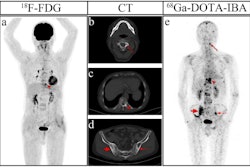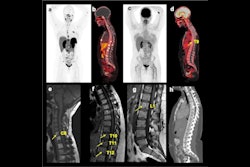F-18 FDG-PET/CT performs better and is more cost-effective than CT in determining biopsy sites for suspected bone metastases, according to a study published November 24 in Cancer Imaging.
In a prospective trial that included 273 patients, F-18 FDG-PET/CT yielded a significantly higher diagnostic success rate for evaluating bone lesions, the study found.
“Our study compared F-18 FDG-PET/CT with CT in a prospective randomized controlled trial for the first time and confirmed that F-18 FDG-PET/CT has higher accuracy and sensitivity than CT,” noted lead authors Yujie Chang, MD, and Yifeng Gu, MD, of the Shanghai Jiao Tong University Affiliated Sixth People’s Hospital in China.
More than 50% of all cancers develop bone metastases and bone is the third most common site of tumor metastasis, with only the lungs and liver having a higher metastatic rate, the authors explained. Bone biopsy is the gold standard for diagnosing bone metastases, yet there is no clinical consensus regarding the optimal imaging test for determining the puncture site, they noted.
Thus, the researchers conducted a prospective study to determine whether F-18 FDG-PET/CT could determine puncture sites more accurately than CT to improve diagnostic rates. All 273 patients were randomly assigned to undergo either CT or F-18 FDG-PET/CT before diagnostic biopsies.
Puncture sites were selected based on the presence of hypermetabolic bone lesions, which was represented by the maximum standard uptake value (SUVmax) in the F-18 FDG-PET/CT group; in the CT group, the puncture site was selected by an interventional radiologist based on the CT scan, the authors noted.
In the F-18 FDG-PET/CT group (n = 137), 81 patients had malignant bone metastases and 56 patients had benign bone lesions. F-18 FDG-PET/CT detected 80 out of 81 actual malignant metastases, with three benign lesions misinterpreted as malignant bone metastases. Thus, F-18 FDG-PET/CT achieved a sensitivity of 98.8% and a specificity of 94.6%, according to the findings.
Of the 136 biopsies performed in the CT group, 89 were positive for malignant bone metastases and 47 were benign bone lesions. CT detected 83 out of 90 actual malignant metastases, with six benign lesions misinterpreted as malignant bone metastases. This resulted in a sensitivity of 92.2% and a specificity of 86.9%.
“The main finding of our study is that F-18 FDG-PET/CT is more suitable than CT in determining the bone biopsy site for suspect bone metastases,” the authors wrote.
In addition, the group noted that the cost of F-18 FDG-PET/CT scans was 11,428 yuan ($1,575) and the cost of CT was 13,287 yuan ($1,832), with the higher cost for CT attributed to a significantly higher rate of second biopsies resulting from unsatisfactory initial biopsies (5.15% vs. 2.19%).
“We recommend F-18 FDG-PET/CT as an imaging test to localize the site of bone biopsy,” the authors concluded.
The full study is available here.




















